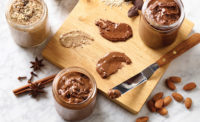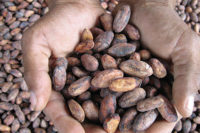Healthy indulgence, transparency, sustainability all play important role for chocolate in snack and bakery products
Chocolate brings the best qualities of health and indulgence to snack and bakery products




Chocolate is one of the most popular and widely consumed products. Everyone likes chocolate. On average people consume 12.57 pounds of chocolate per year. And snacks and baked goods provide many opportunities for people to enjoy chocolate.
Healthy indulgence
“The trend of healthy chocolate and ‘better for you’ snacks falls into two different categories,” says Wouter Stomph, senior manager, product development and innovation, Olam Cocoa, Bolingbrook, IL. “‘Chocolate plus’ enriches products with additions like supplements and ‘chocolate minus’ reduces ingredients like salt and sugar. In response to these growing consumer trends, Olam Cocoa has created several cocoa ingredients that allow manufacturers to both reduce salt and sugar levels, and also add the likes of probiotics without compromising on flavor.”
The use of cocoa powder is a great way to make products both delicious and more nutritious. Olam Cocoa recently introduced a new cocoa powder with a 0.5 percent fat content under their deZaan line of premium cocoa powders. “Known as D00ZR, this cocoa powder allows bakery products to maintain the rich flavor and texture normally associated with full-fat cocoa powder. It also means that when combined with other low-calorie ingredients, like alternative sweeteners, snacks containing D00ZR can be labelled as ‘low fat.’ This cocoa powder works particularly well in delicate bakery products like macarons and meringues, as its low fat content preserves their structure, smooth surface and crunchiness,” shares Stomph.
Additional product offerings include cocoa ingredients that can reduce both sugar and salt. D11BK black cocoa powder is an example of an ingredient that manufacturers can use that is free from any added sodium.
Sugar reduction continues to gain momentum, and consumers are looking for natural ingredients that can deliver sweetness. “Almond butter is a great option for product developers looking to bring sweetness and creaminess to chocolate snack and bakery products, particularly those with ‘low sugar’ claims, and its subtle flavor makes it a versatile ingredient which can be used to add texture and viscosity and as topping or layer. Product developers are also adding chocolate or cocoa into almond butter to bring a premium feel to snack and bakery products that might not otherwise feature chocolate,” notes Harbinder Maan, associate director, trade marketing and stewardship, Almond Board of California, Modesto.
Barry Callebaut, Chicago, also notes that better-for-you products remain a large trend across all segments. The company offers nut-butter-filled inclusions under their Gertrude Hawk line. These inclusions provide a healthy halo to products due to their nut butter centers. In addition, the company offers reduced sugar, no added sugar and no sugar options that can be used in a range of snack and bakery applications including: snack bars, bakery items and cookies.
Cargill, Minneapolis, notes that consumers are seeking “foods with benefits,” and that protein is a highly sought-after nutrient. “Cargill Cocoa & Chocolate offers customized, protein-fortified products leveraging various protein sources, from dairy to plant based. Our customers can take advantage of using our compounds as a delicious tasting vessel for increasing protein in their applications,” states Gretchen Hadden, marketing manager.
Puratos, Pennsauken, NJ, has also developed several new chocolate items with high protein content. These new ingredients can be used in snack and protein bar applications to deliver high protein claims and elevate the health and wellness attributes of the products.
Treat yourself
While consumers are looking for healthier options, they are still demanding indulgent, premium and multi-sensory experiences. Barry Callebaut acquired Gertrude Hawk Ingredients at the end of 2017. Gertrude Hawk Ingredients is a leading manufacturer of miniature confectionary molded shapes. These innovative inclusions help create a unique eating experience for snack and bakery applications.
“Gertrude Hawk’s newest inclusions are created to give the consumer a multi-layered experience through contrasting textures or levels of creaminess, such as peanut butter mini cups or boozy brown butter bourbon truffles, which coat real Kentucky bourbon and brown-butter caramel in a chocolatey enrobing. These multisensorial and multi-flavored textural inclusions offer excitement and diversification to the portfolio for bakery applications,” says T. J. Mulvihill, vice president, marketing, Americas, Barry Callebaut. For snack developers, these ingredients provide the opportunity to offer consumers various shapes, flavors and textures in products like cookies, among others. “On the bakery front, they can be used as a topping or decoration on cakes, pies, doughnuts, cupcakes and more.”
Mulvihlll noted seeing another trend in the category—a move toward more rustic, non-uniformed chunks. He explains these offer a more artistic and home-made look to the products, which can provide the feel that the item was prepared just for the consumer.
Pleasing pairings
“One of the many incredible attributes of chocolate is its ability to pair with a variety of different flavors and ingredients,” says Hadden. “On the snacking side we often see chocolate paired with nuts, nut butters or superfoods such as açaí or goji berries. Conversely, as the lines between health and indulgence blur to create a ‘permissible indulgence’ space, chocolate is being leveraged to deliver a delicious sensory experience with flavor profiles such as s’mores or brownies. One segment of chocolate not to be overlooked when it comes to ingredient pairing is white chocolate. Its versatility to bring other flavors to life is unprecedented thanks to its unbiased flavor profile made up of sweet milky notes and hints of vanilla, coupled with an absence of chocolate liquor.”
Barry Callebaut’s chefs also create new and innovative chocolate experiences by pairing chocolate with a range of different ingredients, including: nuts (hazelnuts, almonds and peanuts, to get a great sweet and salty combination), caramels, fruits (dried cherries, raisins, citrus and blueberries), spirits (bourbon and brandy), spices (cinnamon, clove and cayenne), coffee, marshmallow, vanilla, and cream cheese.
Almonds retained the top spot as the No. 1 ingredient in ideal consumer chocolate products according to a recent survey conducted by Sterling Rice Group and supported by Innova Market Insights. The same study noted consumers believe almonds make chocolate higher quality and more satisfying and nutritious. “We are seeing trends like clean label and healthier snacking drive new formulation opportunities for chocolate in the snack and bakery categories. There is great opportunity for manufacturers to pair chocolate with nutritious ingredients, such as almonds, to create innovative products that meet consumer desires for a healthy experience that still delivers satisfaction and a premium experience offered by chocolate,” shares Maan.
Stomph notes there is a misconception that chocolate and fermented dairy do not work well together in snack and bakery applications. “It is true that cocoa powder can have bitterness that does not complement the sour notes of fermented dairy products, but when the right ingredients are used, this pairing can create a range of delicious snack combinations. In order to make manufacturing these product easier, deZaan has created Fresco Cacao F11FR, a mild and non-bitter cocoa powder. The great thing about Fresco Cacao is that it enhances the fruity flavor of cocoa while reducing its natural bitterness so that manufacturers don’t need to use extra sugar or a masking agent to disguise the taste.”
Sustainability and transparency
Consumers are demanding ethical values and brands that support sustainably farmed chocolate. Chocolate sourced from sustainably farmed cocoa accounted for 8 percent of the global market in 2017, according to data from Euromonitor. In the past few years, there has been a shift, and companies are taking ownership and responsibility for their sourcing strategies. Companies are analyzing and mapping their supply chain to understand any potential social, environmental and economic impacts.
Barry Callebaut has made a commitment to have 100 percent sustainable ingredients in all of its products by 2025 as part of its Forever Chocolate Strategy. This applies to all its ingredients from cocoa and vanilla, to sugar and nuts. “As of November 2018, Barry Callebaut was proud to announce that 44 percent of the cocoa and 44 percent of the other ingredients that the group uses for its products are sustainably sourced,” says Mulvihill. He also noted that Barry Callebaut has more staff in origin countries, which helps support the goal of becoming fully sustainable.
Puratos is also committed to a sustainable future for chocolate. Jaina Wald, product manager, chocolate, explains: “To accomplish this vision, we’ve developed a sustainable cocoa sourcing program, Cacao-Trace, which focuses on the post-harvest fermentation of cocoa beans to produce superior-tasting chocolate while helping cocoa farmers earn a sustainable living through the Next Generation Cacao Foundation. Our ingredients start with our Cacao-Trace farmers who take pride in growing sustainable cocoa beans across the globe. And thanks to an intense focus on fermentation, soil, climate and genetic variety, only the highest-quality, full-flavor beans become Cacao-Trace chocolate. What makes Cacao-Trace unique is the mutually beneficial relationship between farmers and the Next Generation Cacao Foundation which helps cocoa farmers earn a sustainable living by increasing the value of their cocoa.”
Puratos has developed a range of ingredients leveraging their Cocoa Trace cocoa sourcing sustainability program. These ingredients are made exclusively with segregated Cocoa-Trace cocoa mass that is obtained from beans that are fermented and dried according to the company’s strict guidelines. These ingredients can be used in a range of different bakery and snack applications and help improve the quality, taste and sustainability of the products.
Olam Cocoa also has its own sustainability and traceability program, which offers fully segregated ingredients and a wide origin footprint across all of the major cocoa growing regions, notes Stomph. This allows the company to source traceable cocoa beans through its own supplier network to make any ingredient traceable.
Regardless of whether consumers are looking for healthier options or indulgence, both segments of the category will continue to innovate and grow, but will do so with transparency and sustainably sourced ingredients.
Looking for a reprint of this article?
From high-res PDFs to custom plaques, order your copy today!








